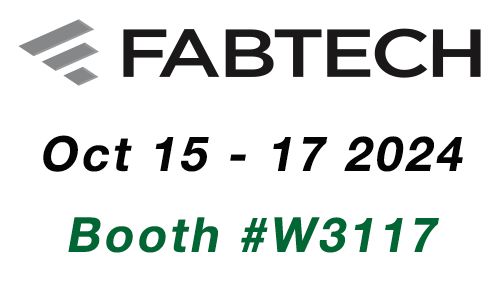Industrial Hand-Held Grinding and Surface Finishing - A Primer on Brush and Mirror Finishing
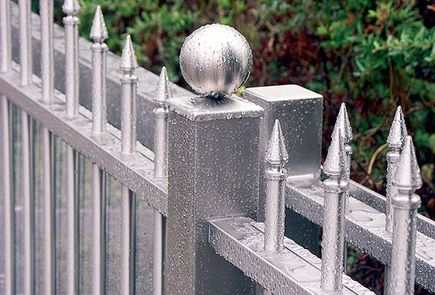
Finishing stainless steel, aluminum and other nonferrous metals presents many challenges. Having the right equipment and following the appropriate steps not only produce the desired results, they save you time and effort. Welding, bending, drilling, and other fabricating processes take their toll on the metal plate or pipe. This is why it usually is best to wait until those steps are completed before undertaking finishing processes. This way, the finish will be consistent on all visible surfaces, as is the desired effect.
The following primer on two common industrial finishes for both flat and curved constructions – brush finishing and mirror finishing – discusses both linear grinders and angle grinders (disk sanders).
Brush, Satin, and Matte Finishing
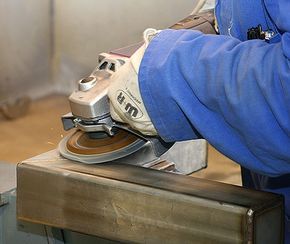
Stainless steel and nonferrous fabrications often have protruding weld seams and scratches after the initial fabrication. Very thick welds, if present, should be removed with a flap disk before continuing with the steps to apply a brush, satin, or matte finish to these materials.
If thick welds or deep scratches are not present, use a 60- or 80-grit zirconium belt for coarse pregrinding.
Next, use a medium-grit, nonwoven abrasive belt to remove the rough surface.
Finally, use an 80-grit, nonwoven abrasive wheel while working the material with a back-and-forth motion to provide an industrial (brush) finish.
Please note that you can use finer-grit wheels (such as 180 and 280) and vary the machine’s speed to make fine adjustments to the finish.
Mirror Finishing
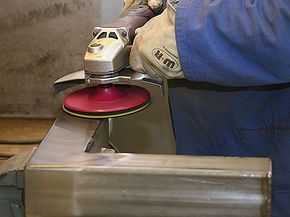
With a mirror finish, any imperfections not addressed in the pregrinding and prepolishing steps will be magnified when the mirror finish is applied. It is important to take the time to do it right the first time. Typically, mirror finishing stainless steel and nonferrous metals requires the use of sisal. In the steps described next, it is not needed.
Utilizing an abrasive with a pyramid-shaped grit structure allows you to pregrind and prepolish the material while leaving a fine finish. This fine finish is enhanced to a mirror shine by using a fine nylon fleece disc and polishing paste.
Remember to work perpendicularly to cover the grain created by each previous step. After each step, use sodium bicarbonate lime powder and a microfiber cloth to remove any paste residue.
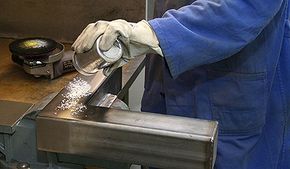
When applying the mirror polish, work in one direction to achieve a clear, shadow-free finish. Additionally, a new nylon fleece should be used for each polishing paste and cream so the different grit sizes are not mixed.
Heat Discoloration
Heat discoloration is common on welded stainless steel. To clean the weld and remove the discoloration, you can use an 80-grit combination abrasive wheel on a linear grinder or disk sander. The combination wheel is composed of nonwoven nylon fleece impregnated with aluminum oxide. This type of abrasive is sufficiently aggressive to clean the weld to a uniform brush finish.
Mirror Finishing Stainless, Nonferrous Metals With a Linear Grinder
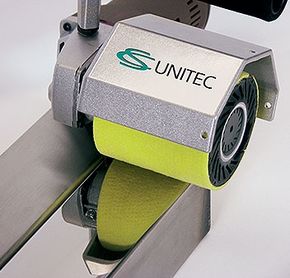
Using a hand-held linear grinding machine is an easy, cost-effective way to polish large and small pieces to a mirror finish. First, pregrind and prepolish with the pyramid-shaped abrasive grit mentioned previously. A nylon fleece and a medium-grit polish paste can be used to further refine the surface.
Next, a fine polish compound and a new fleece will complete the main polish. Finally, a new fleece should be used to apply the polishing cream and impart the mirror finish; remember to work in only one direction for this final finishing step.
Grinding and Polishing Pipe Constructions
Grinding and finishing open and closed pipe constructions can be a difficult task because there are more “sides” to the project. Taking the time to choose the proper equipment for the pregrinding steps is important to ensure that work will not need to be repeated twice. First, a high-quality aluminum oxide grinding belt in a grit that meets the task requirements is recommended. If welds need to be leveled, the application demands a coarser grit (40). If only scratches are present, a finer grit (60-80) is appropriate.
Alternatively, abrasive belts with a pyramid-shaped grit structure can be used for the final grinding before the polishing steps are taken. Nonwoven nylon fleece belts can be used to achieve a brush finish.
If a mirror finish is desired, you can use a super-polish wool belt to apply a medium-grit polishing paste, followed by a fine-grit paste (with a new belt, of course). Finally, use polishing cream and a new belt to achieve a mirror finish. Be sure to work the full 360 degrees of the pipe.
Any remaining paste or cream residue can be removed with a clean wool belt or sodium bicarbonate lime powder and a microfiber cloth.
Mirror Finishing Stainless, Nonferrous Metals With an Angle Grinder
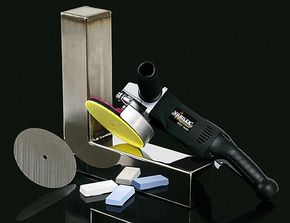
Speed-controlled angle grinders and polishers are versatile, economical tools for finishing stainless and other nonferrous metals. These machines accommodate Velcro®-based abrasive disks, which makes it easier to change media between steps.
Deep scratches and protruding welds can be removed with standard flap disks before utilizing a Velcro system. Remove minor scratches or roller marks with pyramid-shaped grit or other coarse-grit abrasives.
Next, use a medium- and then fine-grit polishing paste with a new disk for each to prepare the surface for final mirror polishing. Finally, use a high-gloss polishing cream to complete your task. Remove any residue with sodium bicarbonate and a microfiber cloth.
Mirror Finishing Aluminum With a Speed-controlled Angle Grinder
Finishing aluminum presents similar challenges, although it is trickier, because it is much softer than stainless steel. With aluminum, the pregrinding steps are very important to ensure that a smooth, blemish-free surface is achieved. A nylon fleece disk should be used to pregrind aluminum. Fleece is rough enough to remove scratches and imperfections, yet soft enough that it doesn’t mar the surface more than required. As with stainless, any imperfections not addressed during the early finishing steps will appear magnified when the mirror finish is applied.
Next, apply a fine-grit polishing paste to a polishing disk and work the material at a low speed on the aluminum. The surface should be polished until a mirror finish is achieved.
Finally, for a completely shadow-free mirror finish, apply a high-gloss cream evenly to a new nylon disk and polish the aluminum. Remove any residue with a new, untreated nylon disk.
To protect ground or polished surfaces, remove all residue and marks from fingerprints, grinding dust, oil, and grease with a high-quality liquid spray designed for cleaning stainless steel and nonferrous metals. Then use a microfiber cloth to apply a high-quality liquid sealant for stainless steel and wipe dry. This will protect the surface for several weeks and ensure that the polished areas will not discolor.
Just like the old adage “measure twice and cut once,” prepare your material properly during intermediate and final grinding to achieve the industrial brush or mirror finish you desire.
 Urgent Weekend/Holiday Fulfillment Available - Click For Details
Urgent Weekend/Holiday Fulfillment Available - Click For Details 




